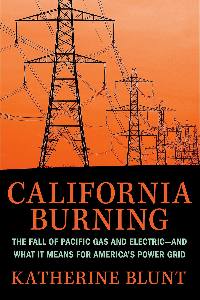Tragedy in paradise tells a story of human incompetence and greed
Books often seek to lure you in with a strong hook. California Burning instead begins with a shoddy one. A century old and made of steel, it broke clean off the side of a transmission tower in 2018. The high-voltage cable it supported fell, providing the spark for the Camp Fire, the twee name for a record-breaking deadly blaze. It destroyed the town of Paradise and killed at least 84 people.
© Handout
The question of how that hook, which cost 56 cents when bought in 1919, was able to sit unmaintained and uninspected for so long, forms the starting point for Katherine Blunt’s engaging dissection of Pacific Gas & Electric, the state’s largest energy provider.
Distilling the myriad factors behind why California continues to burn so ferociously is no straightforward goal. The arguments offered range from the ignorantly simplistic — such as Donald Trump’s suggestion California needs to merely “rake” the forest floors to stop wildfires — to the hopeless: climate change means such disasters are inevitable and policymakers are almost powerless to do anything without a global move to reduce carbon emissions.

In an effort likely designed to broaden the book’s appeal to readers outside California, Blunt posits that PG&E’s problems are an early warning sign for other custodians of critical energy infrastructure in the US, particularly as climate change-related pressures mount.
These themes are only briefly explored, however. But no bother. Readers may not have heard of PG&E, which with a $31bn market value is some way off being the largest energy player in the country. But its story comes in a recognisably irresistible form: juicy backroom dealings, Wall Street leeches, hapless politicians. All that is missing is a comeuppance — for shame.
While wildfires have been the cause of the most negative headlines in recent years involving PG&E, Blunt takes time to explore the group’s other failings, such as deadly explosions because of leaking gas pipelines. After one incident, blamed on poor welding left unchecked for more than 50 years, PG&E was asked by regulators how many pipelines could be at risk from the issue. “God knows,” came the answer.
That’s a recurring theme: a staggering lack of data on the sprawling utility’s operations — the state of its power lines, transmission towers, pipes or even trucks. The company knew barely anything about itself, and for a time had little to no interest in finding out. Records were missing, undigitised or incorrect and incomplete. Inspections were farmed out to those with incentives to find nothing wrong.
The book goes deep on the contractual and policy minutiae that created the conditions for everything to go so wrong. It’s dense in places, but Blunt keeps her storytelling fresh with some great in-the-room set pieces. Some of the most entertaining exchanges take place within the corridors of power in California’s state government, with a mood reminiscent of HBO’s The Wire. In one clash over PG&E’s severe budget deficit, a Democrat state senator tosses a crumpled dollar bill at Gray Davis, telling California’s beleaguered governor: “The buck stops with you.”
This story originally appeared on: Financial Times - Author:Dave Lee

 © Handout
© Handout















